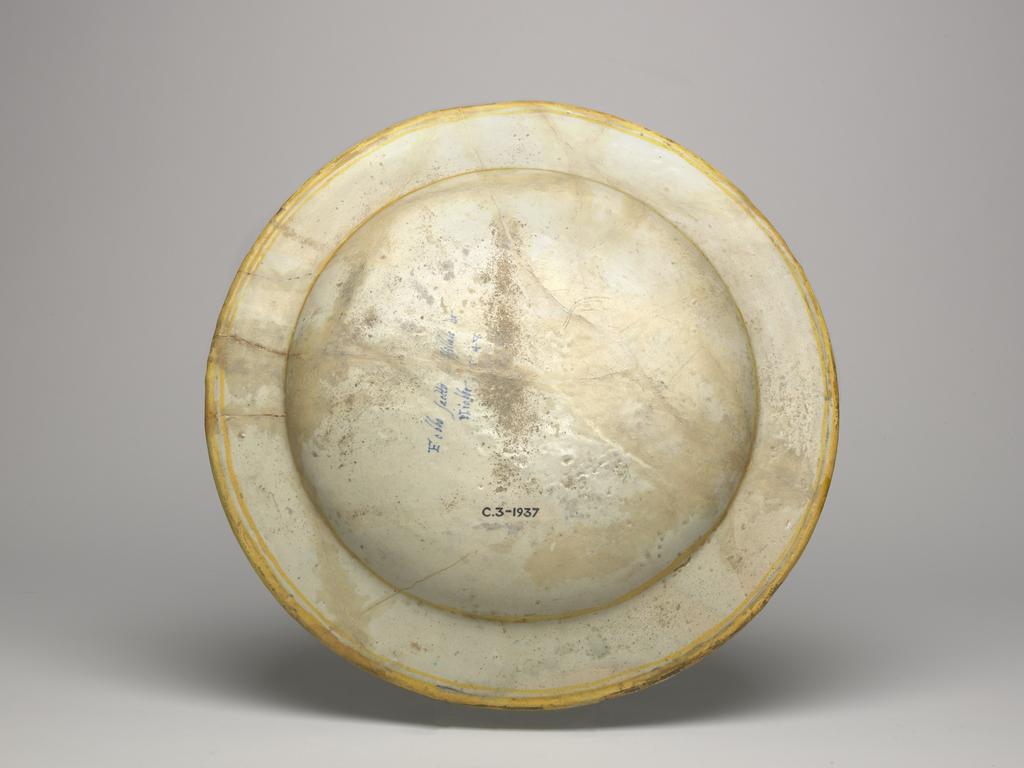Maiolica dish. Apollo slaying the Sons of Niobe. Guido di Merlino, workshop, possibly (Italy, The Marches, Urbino). Polidoro da Caravaggio (Polidoro Caldara), painter, after (Italian, 1490/1500-1543). Shape approximately 64 with plain rim. Circular with almost flat rim, and wide shallow well; warped in firing. Apollo stands on the left, firing his bow towards the stampeding horses of the sons of Niobe, five of whom are wholly or partly visible. Behind Apollo is the head of an old man. Further back to left there is a group of trees on either side of a rock, and to right, the citadel of Cadmus and two trees. In the distance there is a landscape with a mountain. A black band and a wider yellow band encircle the outer edge. The back is inscribed in the middle in blue: `Febbo saetto li ffillole de/Niobbe .548' (Phoebus shoots the sons of/Niobe). Earthenware, tin-glazed overall; the reverse pale beige. Painted in blue, green, yellow, orange, stone, brown, manganese-purple, black, and white, height 4 cm, diameter, rim, 42.8 cm, dated 1548. Renaissance.
Production Note: The design was derived from the facade of the Palazzo Milesi, via della Maschera d'Oro, Rome, which Polidoro da Caravaggio (1492-1543) completed before the Sack of Rome in 1527. It was the most celebrated of his facades and was the last of those listed by Vasari. The facade has deteriorated so that only the faintest shadows of its former splendour remain. But the whole scheme can be seen in Enrico Maccari's Graffiti e chiaroscuri esistenti nell'esterno delle case di Roma, undated but published in 1876. The frieze illustrating the story of Niobe ran from left to right along the facade above the doorways and below the first-floor windows. No print of this facade is known before 1548 so presumably the painter of the dish had access to drawings made in Rome.
Image data
- Accession Number: EC.3-1937
- Photograph copyright © The Fitzwilliam Museum, Cambridge.
- Aperture: f/19.0
- Focal length: 80
- Camera: Hasselblad H3DII-31
- Photographer name: Sam Cole
- Image height: 960 pixels
- Image width: 1024 pixels
- Processed with: Adobe Photoshop Lightroom 5.0 (Windows)
- Filesize: 181.70kB
- Exposure time: 1/45
- ISO Speed: 100
- Fnumber: 19/1
- Captured: 2018:03:06 12:06:59
Key words
16th Century
animal
animals
Apollo
arrows
bow and arrow
bowman
Cadmus
circular
citadel
dish
earthenware
Fitz_AA
glazed
Guido di Merlino
High Renaissance
horses
Italian
maiolica
male nude
mythological
mythology
Niobe
nude
Phoebus
Polidoro Caldara
Polidoro da Caravaggio
pottery
Renaissance
round
slain
slayer
slaying
stampede
stampeding
tin-glazed




